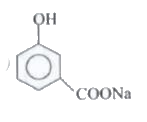An alcohol (A ) on dehydration gives (B) which adds bromine molecule to give (C ), (C ) on heating with sodamide gives (D) which on hydration in the presence of Hg++/H2SO4 gives (E ). E on reduction by lithium aluminium hydride gives (A). (E ) is also obtained on dry distillation of calcium salt of acetic acid. How many enolisable proton present in the product (E ) ?
2
6
3
0
The correct Answer is:B
To solve the problem step by step, we will analyze the transformations of the compounds mentioned in the question.
Step 1: Identify Compound A
Given that compound A is an alcohol, we can assume it to be isopropyl alcohol (2-propanol), which can be represented as:
A=CH3CHOHCH3
Step 2: Dehydration of A to form B
When alcohol A undergoes dehydration (removal of water), it forms an alkene. The dehydration of isopropyl alcohol leads to:
B=CH3C=CH2
This is propene.
Step 3: Addition of Bromine to form C
The alkene B reacts with bromine (Br2) in an addition reaction, resulting in the formation of a dibromide:
C=CH3C(Br)CH2Br
Step 4: Heating C with Sodium Amide to form D
When compound C is heated with sodamide (NaNH2), it undergoes dehydrohalogenation to form an alkyne:
D=CH3C≡CH
This is 1-butyne.
Step 5: Hydration of D to form E
The alkyne D can be hydrated in the presence of mercuric sulfate (HgSO4) and sulfuric acid (H2SO4) to form a ketone:
E=CH3C(=O)CH3
This is acetone (propan-2-one).
Step 6: Reduction of E to form A
When acetone (E) is reduced by lithium aluminum hydride (LiAlH4), it gives back the alcohol A:
A=CH3CHOHCH3
Step 7: Dry Distillation of Calcium Salt of Acetic Acid
The problem states that E is also obtained by the dry distillation of the calcium salt of acetic acid. The calcium salt of acetic acid (Ca(CH3COO)2) upon dry distillation yields acetone (E).
Step 8: Count Enolisable Protons in E
To find the number of enolisable protons in E (acetone), we look for protons that are adjacent to the carbonyl group (C=O). Acetone has the structure:
E=CH3C(=O)CH3
The two methyl groups (CH3) adjacent to the carbonyl each have three protons. Therefore, the total number of enolisable protons is:
- 3 (from one CH3) + 3 (from the other CH3) = 6 enolisable protons.
Final Answer
The number of enolisable protons present in the product E is 6.
---
Given that compound A is an alcohol, we can assume it to be isopropyl alcohol (2-propanol), which can be represented as:
A=CH3CHOHCH3
When alcohol A undergoes dehydration (removal of water), it forms an alkene. The dehydration of isopropyl alcohol leads to:
B=CH3C=CH2
This is propene.
The alkene B reacts with bromine (Br2) in an addition reaction, resulting in the formation of a dibromide:
C=CH3C(Br)CH2Br
When compound C is heated with sodamide (NaNH2), it undergoes dehydrohalogenation to form an alkyne:
D=CH3C≡CH
This is 1-butyne.
The alkyne D can be hydrated in the presence of mercuric sulfate (HgSO4) and sulfuric acid (H2SO4) to form a ketone:
E=CH3C(=O)CH3
This is acetone (propan-2-one).
When acetone (E) is reduced by lithium aluminum hydride (LiAlH4), it gives back the alcohol A:
A=CH3CHOHCH3
The problem states that E is also obtained by the dry distillation of the calcium salt of acetic acid. The calcium salt of acetic acid (Ca(CH3COO)2) upon dry distillation yields acetone (E).
To find the number of enolisable protons in E (acetone), we look for protons that are adjacent to the carbonyl group (C=O). Acetone has the structure:
E=CH3C(=O)CH3
The two methyl groups (CH3) adjacent to the carbonyl each have three protons. Therefore, the total number of enolisable protons is:
- 3 (from one CH3) + 3 (from the other CH3) = 6 enolisable protons.
The number of enolisable protons present in the product E is 6.
Similar Questions
Knowledge Check
An organic compound A on treatment with CHCl3 and KOH gives B and C, both of which , in turn, gives the same compound D when distilled with Zn dust. Oxidation of D yields E of the formula C7H6O2. The Na salt of E on heating with soda lime give F which can also be obtained by distilling A with Zn dust. Identify F.
A B
B C
C D
D
A mixed salt of calcium acetate formate on dry distillation gives
View SolutionDehydration of ethylene glycol in presence of concentration H2SO4 will give
View SolutionCalcium imide on hydrolysis will give gas (B) which on oxidation by beaching powder gives gas (C) gas (C) on reaction with magnesium give compound (D). (D) on hydrolysis gives gas (B). (B),(C) and (D) are
View SolutionGive balanced equations for the following reactions :
Calcium acetate is subjected to dry distillation.
View SolutionWhich gives aldehyde on hydration by H2SO4 and HgSO4
View SolutionAn organic compound (A)(C5H8O3) on heating with soda lime gives (B) which reacts with HCN to give (C). The compound (C) reacts with thionyl chloride to produce (D) which on reaction with KCN gives a compound (E). Alkaline hydrolysis of (E) gives a salt (F) which on heating with soda lime produces n−butane. Careful oxidation of (A) with dichromate give acetic acid and malonic acid. Give the structures to (A) to (F) with proper reasoning.
View SolutionA ketone A, which undergoes halform reaction, gives compound B on reduction B on heating with sulphuric acid gives compounds C, which forms mono-ozonide D.D on hydrolysis in the presence of zinc dust gives only acetaldehyde. Identify A, B and C. Write down the reaction involved.
View Solution

